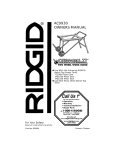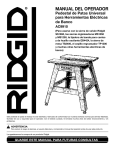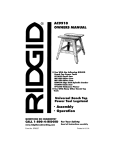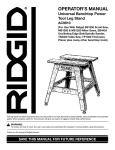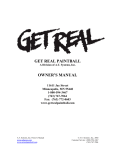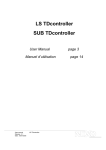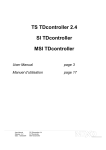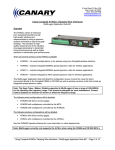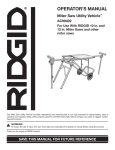Download RIDGID TS2400 Operator`s manual
Transcript
OPERATOR’S MANUAL Work-n-Haul IT Two Wheel Work Stand TM AC9930 For Use With Ridgid TS2400 Table Saw And Ridgid Miter Saws This work stand has been engineered and manufactured to our high standard for dependability, ease of operation and operator safety. When properly cared for, the work stand will give you years of rugged, trouble-free performance. WARNING To reduce the risk of injury, the user must read and understand the operator’s manual before using this product. Thank you for buying a Ridgid product. SAVE THIS MANUAL FOR FUTURE REFERENCE 1 TABLE OF CONTENTS n Introduction ...................................................................................................................................................................... 2 n Rules for Safe Operation .................................................................................................................................................. 3 n Symbols............................................................................................................................................................................ 4 n Unpacking ........................................................................................................................................................................ 5 n Loose Parts ...................................................................................................................................................................... 5 n Tools Needed.................................................................................................................................................................... 5 n Assembly .....................................................................................................................................................................6-10 n Exploded Views/Repair Parts ......................................................................................................................................... 11 n Customer Service Information........................................................................................................................................ 12 INTRODUCTION Your work stand has many features for making the use of this product more pleasant and enjoyable. Safety, performance, and dependability have been given top priority in the design of this product making it easy to maintain and operate. WARNING: Do not attempt to use this product until you read thoroughly and understand completely the operator’s manual. Pay close attention to the safety rules, including Dangers, Warnings, and Cautions. If you use your product properly and only as intended, you will enjoy years of safe, reliable service. Look for this symbol to point out important safety precautions. It means attention!!! Your safety is involved. WARNING: The operation of any tool can result in foreign objects being thrown into your eyes, which can result in severe eye damage. Before beginning operation, always wear safety goggles or safety glasses with side shields and a full face shield when needed. We recommend Wide Vision Safety Mask for use over eyeglasses or standard safety glasses with side shields. Always wear eye protection which is marked to comply with ANSI Z87.1. 2 RULES FOR SAFE OPERATION n NEVER STAND ON WORKSTAND. Serious injury could occur if the stand tips or you accidentally hit the cutting tool. Do not store any items above or near the stand where anyone might climb on the stand to reach them. n Maximum weight of power tool must not exceed 100 pounds. n Always mount miter saw so the workpiece is positioned in-line with the roller assemblies. n Check to make sure workstand does not rock, slide or move prior to use. n Put the workstand on a firm level surface where there is plenty of room to handle and properly support the workpiece. n SAVE THESE INSTRUCTIONS. Refer to them frequently and use them to instruct other users. If you loan someone this product, also loan these instructions. Safe operation of this accessory requires that you read and understand this operator's manual, the operator’s manual for the table saw and miter saw as well as all labels affixed to the tool. READ ALL INSTRUCTIONS n KNOW YOUR ACCESSORY. Read the operator's manual carefully. Learn the product's applications and limitations as well as the specific potential hazards related to this product. n KEEP THE WORK AREA CLEAN. Cluttered work areas and work benches invite accidents. DO NOT leave tools or pieces of wood on the saw while operating. n ALWAYS WEAR SAFETY GLASSES WITH SIDE SHIELDS. Everyday eyeglasses have only impactresistant lenses; they are NOT safety glasses. n DO NOT USE THIS PRODUCT WITH OTHER EQUIPMENT or for other purposes. WARNING: n ALWAYS DISCONNECT THE SAW FROM THE POWER SUPPLY BEFORE ASSEMBLING THIS KIT. Make sure the switch is off when reconnecting the saw to a power supply. Some dust created by power sanding, sawing, grinding, drilling, and other construction activities contains chemicals known to cause cancer, birth defects or other reproductive harm. Some examples of these chemicals are: n BEFORE MAKING A CUT, BE SURE ALL ADJUSTMENTS ARE SECURE. • lead from lead-based paints, n USE THE WORK STAND IN A DRY, INDOOR PLACE PROTECTED FROM RAIN. n KEEP WORK AREA WELL LIGHTED. n PUT THE WORK STAND WHERE NEITHER OPERATORS NOR BYSTANDERS MUST STAND IN LINE WITH THE TOOL’S BLADE. n Always get help if you need to lift the workstand. When lifting, hold the workstand close to your body. Bend your knees so you can lift with your legs, not your back. • crystalline silica from bricks and cement and other masonry products, and • arsenic and chromium from chemically-treated lumber. Your risk from these exposures varies, depending on how often you do this type of work. To reduce your exposure to these chemicals: work in a well ventilated area, and work with approved safety equipment, such as those dust masks that are specially designed to filter out microscopic particles. n When hauling the workstand in a vehicle, securely tie it down to prevent movement and possible damage. n NEVER put the workstand where operator's or bystander are forced to stand with any part of their body inline with the path of the saw blade. 3 SYMBOLS The purpose of safety symbols is to attract your attention to possible dangers. The safety symbols, and the explanations with them, deserve your careful attention and understanding. The safety warnings do not by themselves eliminate any danger. The instructions or warnings they give are not substitutes for proper accident prevention measures. SYMBOL MEANING DANGER: Indicates an imminently hazardous situation, which, if not avoided, will result in death or serious injury. WARNING: Indicates a potentially hazardous situation, which, if not avoided, could result in death or serious injury. CAUTION: Indicates a potentially hazardous situation, which, if not avoided, may result in minor or moderate injury. It may also be used to alert against unsafe practices that may cause property damage. Note: Advises you of additional information concerning the operation or maintenance of the equipment. SAFETY AND INTERNATIONAL SYMBOLS This operator's manual describes safety and international symbols and pictographs that may appear on this product. Read the operator's manual for complete safety, assembly, operating and maintenance, and repair information. SYMBOL NAME MEANING Wet Condition Alert • Do not expose to rain or use in damp locations. No Hands Symbol (Miter Saw) • Failure to keep your hands away from the blade will result in serious personal injury. • Failure to keep your hands away from the blade will result No Hands Symbol (Table Saw) in serious personal injury. Read the Operator’s Manual • To reduce the risk of injury, the user must read and understand the operator’s manual before using this product. Eye Protection • Always wear safety goggles or safety glasses with side shields and a full face shield when operating this product. SAVE THESE INSTRUCTIONS 4 UNPACKING NOTE: Before beginning assembly, check that all parts are included. If you are missing any part, do not assemble this accessory. Call 1-800-4-RIDGID or E-mail us at [email protected] to get the missing part. Sometimes small parts can get lost in packaging material. Do not throw away any packaging until the accessory is completely assembled and attached to your power tool. Check packaging for missing parts before contacting RIDGID. LOOSE PARTS The following items are included: n Stand Assembly (1) n Lower Foot (1) n Hex Bolt, 6 mm x 41 mm (2) n Curved Washers, 6 mm (4) n Lock Nut, 6 mm (2) n Carriage Bolt, 1/4 in.-20 x 3 in. (4) n Lockwasher, 1/4 in. (4) n Wing Nut, 1/4 in. (4) n Flat Washer, 1/4 in. (4) n Operator's Manual (1) STAND ASSEMBLY CARRIAGE BOLT HEX HEAD BOLT LOWER FOOT FLAT WASHER LOCKWASHER WING NUT CURVED WASHER LOCK NUT TOOLS NEEDED 3 The following tools (not included) are needed for properly assembling your workstand. DRILL DRILL BITS (1/4 in., 3/8 in. AND 5/8 in. WOOD BORING BIT) CLAW HAMMER WRENCHES 10 mm (2) FLAT SCREWDRIVER 5 ASSEMBLY ASSEMBLING THE LOWER FOOT MOVING THE CARRY HANDLE SPRING PIN See Figure 1. See Figures 2 and 3. NOTE: Only ONE spring pin is required at the carry handle end of the stand. This spring pin locks the legs in the set-up or tear-down position. Instructions to change the location of this spring pin are described later in the “Assembly” section of this manual. n From carton, and bag of loose parts remove the following: Hex Bolt, M6 x 41mm (2) Curved Washers, M6 (4) Lock Nuts, M6 (2) Lower Foot (1) Stand Assembly (1) NOTE: Only ONE spring pin is required to lock the legs in the set-up or tear-down position. The spring pin can be assembled on either side of the carry handle. To change this location, follow the instructions below: n Note how the spring and washer are assembled before relocating them to the other side. n Hold washer and spring with thumb and forefinger as shown. n Using a flat screwdriver pry the e-clip off the groove in the end of the knob shaft. n Reassemble the spring pin, washers and spring to the other side. The knob must be to the inside. Reassemble the washer, spring and e-clip on the end of the shaft away from the knob as shown. NOTE: Additional tools may be required to attach your power tool to the stand. See “Mounting Power Tools” section of this manual. n Slide lower foot into the stand assembly. NOTE: A dimple has been placed on one side of the workstand frame to aid in proper assembly alignment of the foot as shown. KNOB NYLON WASHER SPRING n Attach the lower foot on each side with a hex bolt, curved washers, and a lock nut as shown. n Firmly tighten the nuts with two 10 mm wrenches. HEX BOLT CURVED WASHER LOCK NUT Fig. 2 KNOB SPRING DIMPLE IN FRAME E-CLIP Fig. 1 NYLON WASHER 6 STEEL WASHER Fig. 3 ASSEMBLY WORK STAND SET-UP n At the wheel end of the stand firmly grab the lift handle and with the other hand pull the spring pin knob near the right front wheel. See Figures 4, 5, 6 and 7. Before you start n Remove any workpieces from the tool. CAUTION: n If the tool is already assembled to the stand, make sure that it is securely attached to the stand per the instructions in this manual. Do not lift by any part of the miter saw that is attached to the workstand. Failure to do so may result in possible injury and damage the tool. UPRIGHT POSITION LIFT HANDLE SPRING PIN KNOB Fig. 4 n Remove or securely store any tool accessories such as clamps, miter gauge, fence, guard, etc. that may be on the work stand. LOCK THE LEGS Fig. 6 WARNING: To avoid serious personal injury when lifting, bend your knees so you can lift with your legs, not your back. n For table saws, lower the blade all the way down into the cabinet or base. n For miter saws or other tools, lock the cutter head or other movable portions of the tool in the stored position. n Pull up firmly on the lift handle until sliding leg is vertical. n Release the pin and lower the handle to latch the leg. Shake the handle up and down to make sure the sliding leg locks into position before releasing the handle. Setting Up n From the upright position, hold the leg cross bar and pull the pin. NOTE: You may need to adjust the speed at which you bring up the table in order to get the sliding leg to latch. n Lift legs up until they lock in place. WARNING: n Lower unit until the legs rest on the ground. To reduce the risk of injury, make sure sliding leg is secured in the notch with the spring pin. Failure to latch may cause stand to fall in use. PULL PIN SPRING PIN KNOB LEG CROSSBAR SLIDING LEG Fig. 5 Fig. 7 7 ASSEMBLY WORK STAND FOLD DOWN NOTE: You may need to adjust the speed at which you bring up the table in order to get them to unlatch. See Figures 8, 9, 10 and 11. Before you start n From the other end of the stand, pull the spring pin knob and lift stand into the upright position. Push the legs until they lock into place against the bottom of the table. n Remove any workpieces from the tool. n If the tool is already assembled to the stand, make sure that it is securely attached to the stand per the instructions in this manual. n Make sure the stand will remain upright on its own. CAUTION: n Remove or securely store any tool accessories such as clamps, miter gauge, fence, guard, etc. that may be on the work stand or tool. If the stand will not remain upright, always store this tool and stand on the floor in the horizontal position. n For table saws, lower the blade down into the cabinet. n For miter saws or other tools, lock the cutter head or other movable portions of the tool in the stored position. LIFT HANDLE SPRING PIN KNOB PULL THE SPRING PIN SLIDING LEG Fig. 8 Folding Down PUSH THE LEGS n Pull the spring pin on the wheel end of the stand. n Fully lift table by the lift handle. n Slowly lower this end of the table down to the frame. n You may now roll the stand to the next location. NOTE: If desired, with the help of a second person, the foot of the stand may also be used as a carry handle as shown. WARNING: To avoid serious personal injury when lifting, bend your knees so you can lift with your legs, not your back. LOWER THE TABLE Fig. 10 Fig. 4 Fig. 9 8 ASSEMBLY SET-UP POSITION MOUNTING POWER TOOLS WARNING: Failure to unplug the tool could result in accidental starting causing possible serious personal injury. Before you start RIDGID TS2400 table saw bolts directly onto this work stand. Most other tools, including miter saws, will need additional supports to aid in attaching a tool to work stand. The hardware and mounting materials shown in this manual are the minimum size recommended for safe attachment of a power tool to this work stand. Any deviation from this is not recommended. This stand is primarily recommended for use with portable table saws. Other applications such as miter saws and other tools weighing less than 100 pounds are described below. We recommend using wooden mounting blocks as explained below to attach any tool other than the RIDGID TS2400 table saw. Any holes drilled in the work stand or screws attached to the table of the work stand may cause damage to the product or interfere with the function of the work stand. NOTE: In miter saw applications you must build a wood base between the stand and saw. This will prevent interference of longer work pieces with the carry handle. Make sure that you understand how to set-up and tear-down the work stand safely. Saw and work stand combination must be stable in order to operate safely. Fig. 12 Other Portable Power Tools with a Large Base See Figures 13, 15 and 15. (Mounting holes in power tool span 2 x 6 mounting blocks shown) n Place the stand in the set-up position as shown. n Using the stand’s table as a pattern, cut two 2 x 6 s to 24 in. length and locate as shown. From the bottom of the stand mark hole locations. SET-UP POSITION WARNING: To avoid serious personal injury, always assure saw is fully supported and securely attached to a level work surface. If not, relocate to a more stable location. WARNING: To reduce the risk of injury from the tool moving or falling off stand, always check that all mounting bolts and nuts are securely tightened before moving stand or using tool. Fig. 13 RIDGID 10-in. Table Saw Model TS2400 See Figure 12. n Place the stand in the set-up position as shown. n Align the four holes supplied in the work stand table with the four larger holes in the table saw base as shown. n Starting at the carry handle end of the work stand, insert the four supplied carriage bolts up through the table of the work stand and then through the saw base. n Install the washer, lockwasher and wing nut on top and tighten securely. n Drill 1/4 in. or 3/8 in. diameter holes in the two 2 x 6 mounting blocks. n Temporarily attach the mounting blocks to work stand with the supplied bolts or 1/4-20 bolts at least 2-1/2 in. long. Secure with washers, lockwashers and nuts. n To attach your power tool locate and drill holes in mounting blocks. NOTE: A 5/8 in. diameter counterbore 1/4 in. deep is required for clearance between the bolt head and the work stand table. Tap carriage bolt with hammer to seat bolt fully into the hole and counterbore. 9 ASSEMBLY SEE BOLT VIEW A SEE BOLT VIEW B n Temporarily attach the mounting blocks to work stand with the supplied bolts or 1/4-20 bolts at least 2-1/2 in. long. Secure with washers, lockwashers and nuts. n Locate and drill holes in 2 x 6 mounting blocks and 1 x 4 cross pieces, as shown. Plywood 3/4 in. thick, 24 in. x 27 in. may be used in place of the 1 x 4 s. n Loosen 2 x 6 mounting blocks from work stand table. Attach two 1 x 4 cross pieces to the mounting blocks with 1/4-20 carriage bolts at least 2.75 inches long, as shown. Secure with washers, lockwashers and nuts. NOTE: A 5/8” diameter counterbore 1/4” deep is required for clearance between the bolt head and the Fig. 14 SEE BOLT VIEW A n Remove mounting blocks from table. Attach power tool to mounting blocks with 1/4-20 carriage bolts, washers, lockwashers and nuts as shown. Reinstall mounting blocks to work stand table. NOTE: See views of bolt recommendations, see figure 15. POWER 2X6 TOOL WORK STAND BOLT VIEW A (2 X 6s WORK STAND) SEE BOLT VIEW B BOLT VIEW B (POWER TOOL TO 2 X 6s) PLYWOOD SEE BOLT VIEW C SEE BOLT VIEW A-1 Fig. 17 work stand table. Tap carriage bolt with hammer to seat bolt fully into the hole and counterbore. Resecure 2x6 mounting blocks to work stand table. If using plywood, the supplied 1/4-20 bolts may be used to attach the 2 x 6s and plywood to the work stand table. When mounting table saws to plywood an opening for the sawdust to fall through is needed. See your tools owner’s manual for recommended hole size. See views of bolt recommendations, see figure 18. n To attach power tool, locate and drill holes in cross pieces. n Attach power tool to cross pieces with 1/4-20 carriage bolts as shown with washers, lockwashers and nuts. Fig. 15 Portable Power Tools with a Small Base See Figures 16, 17 and 18. (Tool mounting holes do not span 2 x 6 mounting blocks shown.) n Place the stand in the set-up position as shown. n Using the stand’s table as a pattern, locate the 2 x 6 s as shown, and from the bottom mark hole locations. n Drill 1/4 in. or 3/8 in. diameter holes in the two 2 x 6 x 24 in. long mounting blocks as shown. BOLT VIEW A (2 X 6s TO WORK STAND) SET-UP POSITION 2X6 WORK STAND 2X6 POWER TOOL 1X4 2X6 Fig. 16 10 1 X 4 OR PLYWOOD 2X6 BOLT VIEW C (POWER TOOL TO 1X4s OR BOLT VIEW B (1 X 4s TO 2 X 6s) BOLT VIEW A-1 (PLYWOOD AND 2 X 6s TO WORK STAND) WORK STAND Fig. 18 EXPLODED VIEW/REPAIR PARTS 34 * Lubricate if 35 1 Necessary 33 36 32 37 20 30 29 22 21 8 10 * 19 20 9 39 23 38 7 12 4 2 17 13 27 3 11 15 41 15 31 26 24 37 5 14 16 24 6 * 18 25 38 36 * 40 28 Work-N-Haul IT Two Wheel Work Stand Model AC9930 RIDGID parts are at www.ridgidparts.com TM 1 2 3 4 5 6 7 8 9 10 11 12 13 14 15 16 17 18 19 20 21 747-01 747-02 747-03 747-04 747-05 747-06 747-07 747-08 747-09 747-10 747-11 747-12 747-13 747-14 747-15 747-16 747-17 747-18 747-19 747-20 747-21 22 23 24 25 26 27 28 29 30 31 32 33 34 35 36 37 38 39 40 Table Locking Pin Metal Sleeve Spring Washer (10 ID) E Clip Wheel Washer (13 ID) Table Support Nylon Roller Hex Head Bolt (M6 x 15) Washer (6 ID) Axle Shaft Hex Head Bolt (M6 x 41) Contoured Washer (6 ID) Metal Sleeve Front Foot Main Frame E Clip Washer (8 ID) Spring 11 747-22 747-23 747-24 747-25 747-26 747-27 747-28 747-29 747-30 747-32 747-33 747-34 747-35 747-36 747-38 747-39 747-40 747-41 828809 983000-412 Locking Pin Hex Head Bolt (M8 x 62) Washer (8 ID) Hex Nut (M8) Rear Support Washer (10 ID) Cap Molded End Foot Round Head Bolt (M8 x 20) Nylock Nut (M6 x 6) Carriage Bolt (1/4-20 in. x 3 in.) Washer (1/4 in. ID x 1.5 mm) Lockwasher (1/4 in. ID) Wing Nut (1/4 in.) Phillips Head Bolt (M5) Rubber-Stop Hex Nut (M5) Nylon Washer Bag Loose Parts Operator's Manual OPERATOR’S MANUAL Work-n-Haul IT Two Wheel Work Stand TM AC9930 For Use With Ridgid TS2400 Table Saw And Ridgid Miter Saws Customer Service Information: For parts or service, contact your nearest RIDGID authorized service center. Be sure to provide all relevant information when you call or visit. For the location of the authorized service center nearest you, please call 1-866-539-1710 or visit us online at www.ridgid.com. When ordering repair parts, always give the following information: AC9930 Model No. Serial No. 983000-412 3-04 12












